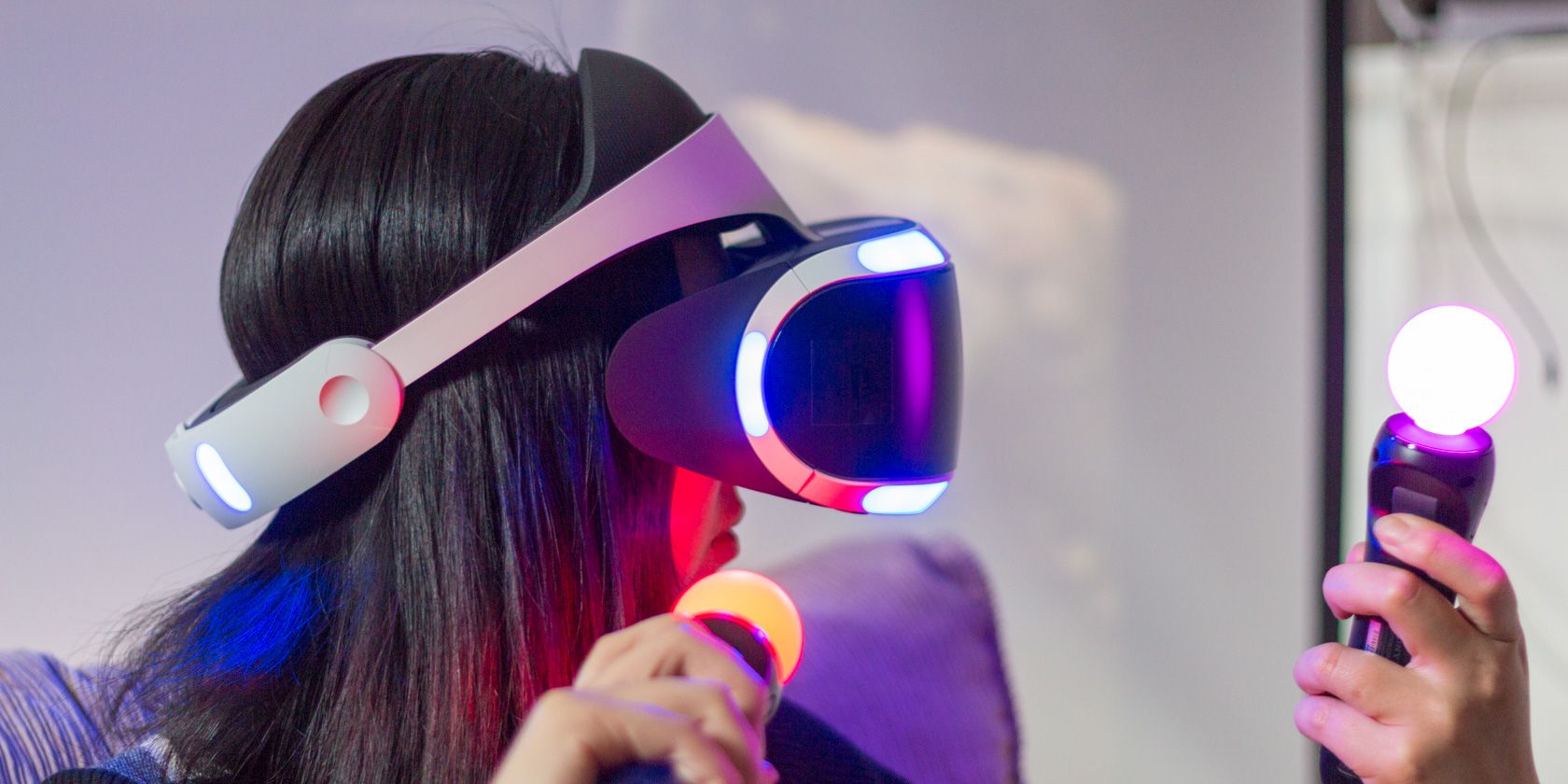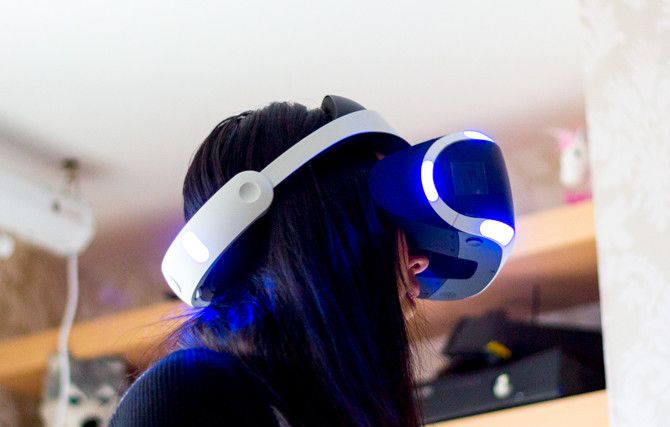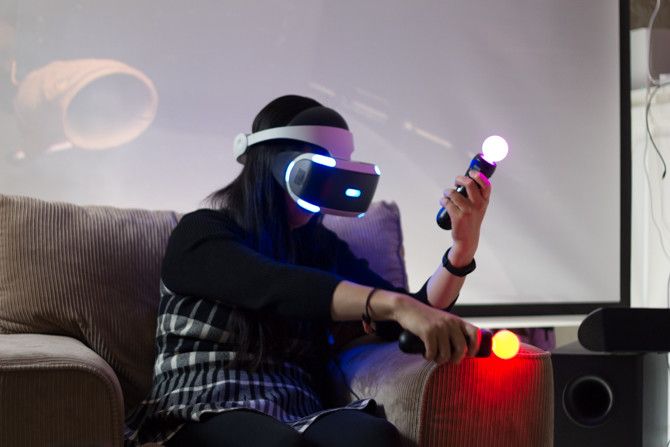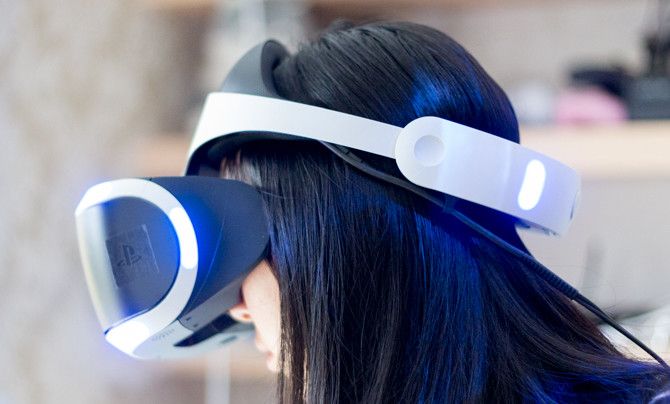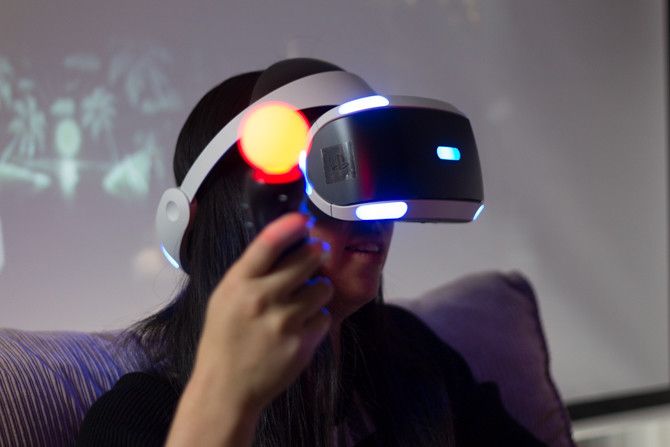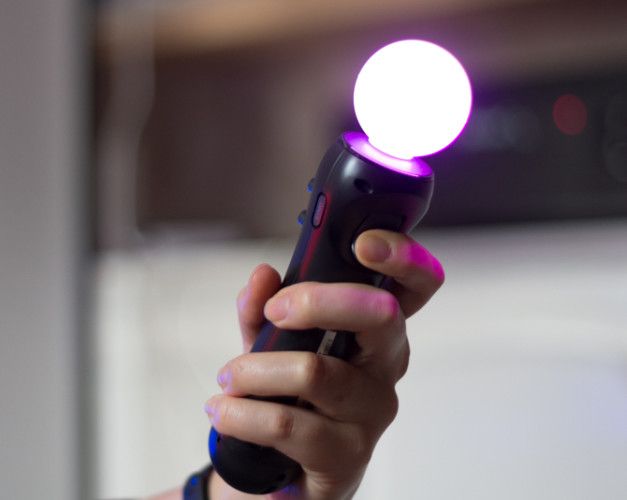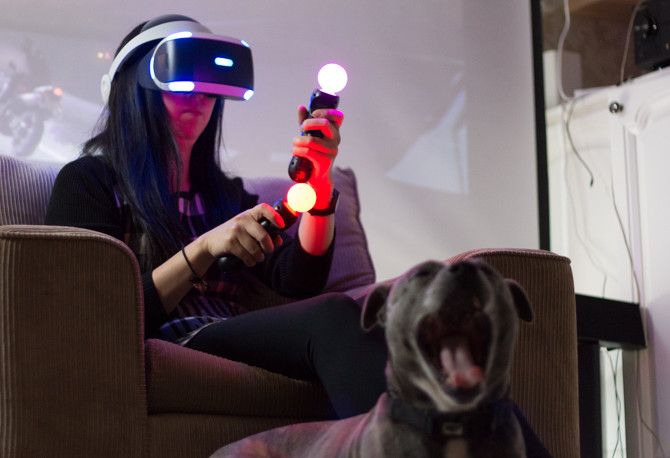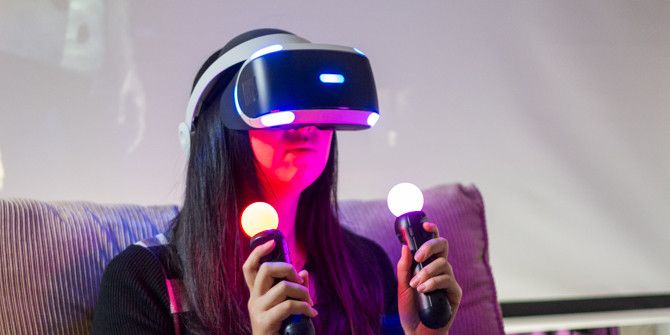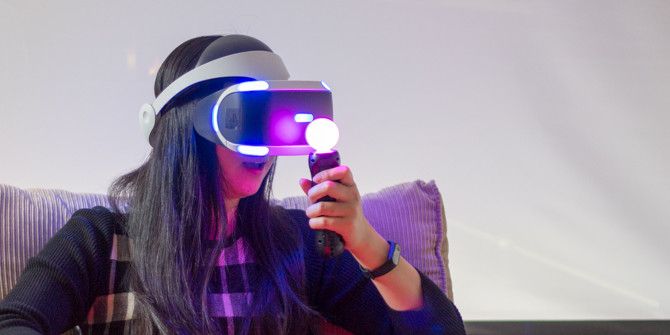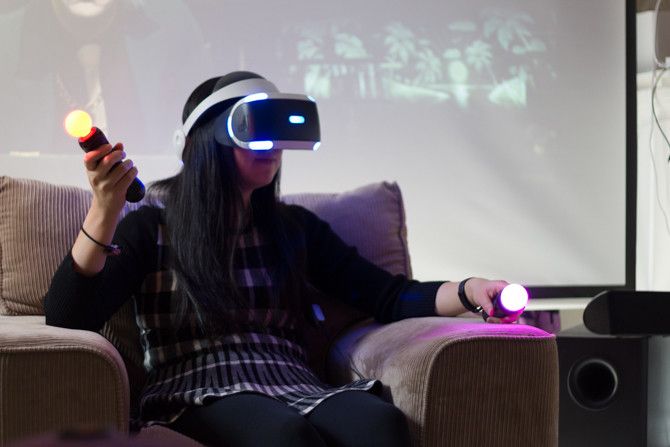Playstation VR
A year ago, I wouldn't have believed that by the end of 2016 we'd have not one, but three, consumer VR headsets available. But here we are. Sony has finally released their low-cost headset to the world, along with a slew of PlayStation games that support the device. Is it worth it, and how does it compare to the other headsets?
Specifications and What's in the Box?
The design draws heavily from Sony's HMZ series of personal cinema displays. Headsets are not at all a new thing for Sony, having gone through 3 or 4 generations of those.
- Resolution: 960 x 1080 per eye, from a single 5.7" 1080p OLED display vertically split down the middle.
- Weight: 610g.
- Field of view: 100°.
- Refresh rate: 120Hz.
- Price: $400 for the bundle, if you can find it; more if you need to purchase components separately.
- Tracking system: camera based with colored LEDs.
Inside the box you'll find the headset itself, the breakout box (which enables the passthrough and "social" mode to the TV), all the required cables (of which there are many), some natty earbud headphones, and a demo disk. If you don't already have one and you bought the non-bundle version of PSVR, you'll also need to purchase a PS Eye camera, and the Move controllers.
The lightweight cable from the headset also features a small inline control box, with volume buttons, power, and a 3.5mm stereo socket for connecting the included earbud headphones, or your own. Neither are required though – you can continue to use your existing surround system as the audio is passed back to your TV or receiver through the HDMI cable.
Setup
Some reviews have lamented the absurd number of cables required, but anyone familiar with an HDMI cable should be able to figure this thing out. Instead of a PS4 going directly to a display device, it goes out to a small PSVR breakout box, which then splits into two: one going to your TV, and one to the headset. The breakout box serves mostly as a mirroring device with no additional processing capability, so unlike it's PC-based equivalents, the PSVR can be easily enjoyed by others in the room who want to know whats going on. It's said that some games will offer a "second view" for non-VR multiplayer participants in the same room, but this has yet to materialize as far as I can tell.
Quick Tip: Use the HDMI cables supplied! This sounds obvious, but I'm the kind of person who leaves micro-USB and HDMI cables in boxes just because I already have hundreds of them from other devices and don't need more clutter. The HDMI cable I was connecting up the PS4 to the PSVR box with wasn't up to spec, so despite getting a regular output on the TV, the required VR signal wasn't being sent, and I couldn't get past the "Connect your cables to your TV like this" setup message.
There's a demo disc in the box, but be warned this has a 6GB optional patch you'll want to download first.
Comfort
Despite being the heaviest of the current crop of VR headsets, the PlayStation VR actually feels like the least heavy due to the rigid head strap, which takes the weight completely away from your nose and cheeks. By pushing a button on the underside, the whole screen unit can actually be pushed away from your face while keeping the head strap in place, giving you a quick glance into the real world or allowing you to adjust the screen distance to something you're more comfortable with.
The prevailing consensus seems to be that the PSVR is the most comfortable headset yet. This is true – once you get it on, there's no feeling of weight on your face at all. However, there's a couple of points that I feel need to be mentioned here.
First, like all headsets, this is not a once size fits all. When positioning the headset, I found it fit perfectly over my glasses, but it was a choice between either having a large amount of light leaking in around my nose, or squishing it down so much that it was harder to breath. Obviously, I must have a humongous stonker of a nose, but this isn't a problem I found on either the Oculus Rift or HTC Vive. Don't take my word for it, or the word of any other reviewer: please go and try it out the headsets for yourself, with someone there who can help you adjust them. For me, the light leakage is quite an immersion breaker.
Second, the thin cable connecting the headset is awkwardly threaded through a loop then dropped down the back of the headset. Putting on requires you to pull the headset band outwards, which feeds some of the cable through that loop. That works well enough, but taking the headset off causes the previous threaded cable to stay put, introducing a bend which may eventually break. Sony has even covered it with a more solid plastic surround casing to mitigate it, so this was evidently an issue they found in durability testing. The Oculus Rift uses a similar design, but isn't affected by the problem I've described. The Vive cable is lot thicker and looser, falling straight over the top of your head and down the back, so it doesn't suffer either.
Finally, I'm worried about the durability of the rubber interface. Despite being quite comfortable, it looks to be entirely non-replaceable, unlike that of the Vive. While the Rift interface can't be removed easily either, it is just a stuck on bit of rubber and we'll likely see third party replacements. The PSVR is a more complex beast, and it's difficult to see how it's going to be replaceable should it eventually come loose.
There's no denying it though: this is certainly a comfortable headset, and shouldn't result in a sweaty O round your eyes after extended use.
Visual Quality
In terms of raw specs, the PlayStation VR screen is about 20% lower resolution than the HTC Vive or Oculus Rift, but appears to be utilizing a better overall quality of screen. This could be due the precise pixel layout, but my point is: it looks quite good. I found less overall screen door effect (the mesh-like overlay that appears due to sub-pixel gaps), and it's sufficiently bright. The lenses also convey none of the telltale concentric rings of the Vive, or "god ray" glares of the Rift, without apparently sacrificing field of view. The lenses do however have a rather small sweet spot: you'll need to adjust the headset quite a lot before the blur is gone. I assume Oculus and HTC both chose fresnel lenses for an increased sweet spot at the cost of other visual artefacts.
Out of the box then, despite the lower resolution, I'd say it's easily on par with both of the PC-based headsets. Of course, if you have enough grunt in your machine, you can supersample Steam games for higher perceived resolution, but that's after you've spent $700 on a top of range graphics card.
Certain types of games really suffer from a low resolution however: space sims and racing. In these, distant objects are a blocky mess that harks back to the first generation Oculus Rift development kit. Eve Valkyrie felt horrible compared to the Rift. Drive Club was so bad it was unplayable.
Sony has suggested that the upcoming PlayStation Pro will give a little graphics quality boost to the PlayStation VR, perhaps using a similar supersampling method. For now though, it's good enough, but not great.
Tracking and Move Controllers
The headset and Move controllers both use an outside in camera-based tracking system similar to the Oculus Rift, though Oculus uses invisible infrared frequency LEDs, while the PlayStation uses visible light. Essentially, the PlayStation Eye camera is looking for the colored lights on the controllers and headset. It's not new technology – it's the same motion tracking system that Sony launched a few years ago to compete with Kinect and the Wii, and its age really shows.
It's an inherently flawed system, one that I suspect Oculus is now coming to regret choosing too (they're recommending at 3 cameras for a full room scale experience), but the PSVR tracking is particularly bad. It's laggy, and susceptible to any bright lights or reflective surfaces, as well as some pretty horrendous drift. Some reviews have even suggested throwing a blanket over leather sofas. In one Playroom VR game, my controller actually drifted so much that it did a complete 90 degree angle turn. When trying to play anything standing up, I was greeted by constant interruptions telling me to move so the headset was inside a very small square of tracking. You're essentially stuck in one place for every gaming experience, and it feels extremely restrictive.
While the same issues with reflective surfaces or bright lights could be said of both the Oculus Rift and the HTC vive, they're a lot less susceptible than the PSVR is. For a lot of the games you probably might not notice, but with this tracking the PSVR will never be able to compete on room scale experiences that require the player to physically lean over or turn around.
With only a single camera to track everything, PSVR remains a forward facing experience, and one that is often plagued by occlusion issues if you turn too far to one side.
The greatest weakness comes when you introduce the Move wands into the equation. Just placing the controllers in front of your head will result in unwanted camera movements as tracking LEDs are obscured.
In general, the whole tracking system just feels sluggish, restrictive, and error prone when compared to other systems. The Move controllers are better than nothing (after all, let's not forget that the Oculus Rift is still a seated experience with only a gamepad at the moment), but ultimately unsatisfying. If you want room scale experiences that allow you to physcially move around, your best option is still the Vive.
Games
There's an awful lot of polished launch titles, but we haven't tried them all. I will say that the included demo disc is a little disappointing, leaving me with "wow" moments few and far between. This could be because the novelty of VR in general has worn off for me, but I'd argue that I still get the wow factor every time I boot up my Vive (my Oculus meanwhile, is collecting dust, until the release of the Touch controllers).
The DriveClub VR demo gave me a headache, which is something I've never experienced from VR before. I suspect the low resolution of distant objects is partly what caused it.
As for full gaming experiences, I tried Rez Infinite and Thumper, both music-based games that are suited to seated gaming and I thought would appeal. They're ok, but only really solidified my thoughts that a VR system without full ability to move around is a little ... inadequate. If you thoroughly enjoy those sorts of games anyway, then VR literally adds another dimension to them.
VR Worlds is also a glorified a demo disc, featuring four or five experiences that last 10-15 minutes. It's included with the full PSVR bundle, but we had to purchase our separately for around £50. The Luge experience is the most thrilling, but harks back to the days of early VR rollercoasters demos. Good to show off the system, but little of substance there. The underwater demo is substandard compared TheBlu on Vive. Again, all of these are only going to seem less than mind-blowing if you've had experiences with other high end VR system. If I was coming from the standpoint of only ever having tried mobile VR or nothing at all, I would be incredibly impressed with this. London Heist is undoubtedly the best of the bunch, utilising the Move controllers for gun play and subtle interactions – but be warned, it has very adult language and is not something you'll be demoing to polite company. It too, is annoyingly short.
There's also a short space combat experience called Jackal Assault available, under the banner of the latest installation in the Call of Duty franchise. It's free, even if you don't own the full Infinite Warfare game. It plays much like Eve Valkyrie, and it doesn't really feel like it ties into Infinite Warfare in any way at all, really. It's not bad, but again highlights the low resolution when targetting far away objects.
I feel I should also mention the outrageous prices being charged. Yes, console gaming has always been more expensive, and there's distribution and production costs for physical media – but still, for a VR system where the one of the major features is simply being cheaper than it's PC equivalents, I'm almost certain any cost difference would be negated in a year or two of ownership due to overpriced games.
One final word, though this may be unrelated to PSVR and more of a criticism of the PS4 itself: the load times are ridiculously long. I admit, I haven't touched a PS4 since Sony support accused me of lying after my account was hacked, so I've probably been spoilt by SSDs on a PC... but wow. Especially when I'm just trying to run through multiple short demos to get a feel for things, waiting a minute or more for them to load is so disappointing.
Availability
Finally, we should note that stock of the PSVR is in fairly short supply right now as pre-orders are being fulfilled, and may evaporate completely as Christmas rapidly approaches. Amazon UK is currently stating they can't fulfil new orders until after Christmas, and that's just for the regular headset-only kit – you'll still need to source the controllers and camera yourself. Amazon US seems to still be in stock at the time of writing, but your best best may to phone around local brick and mortar stores if you're out in the middle of nowhere. The bundle that includes the VR Worlds, Move controllers, camera and headset is only available from price-gouging third party sellers, for at least $650. That's a terrible deal.
[amazon id="B01DE9DY8S"]
Should You Buy a PSVR?
The Optimist's View
Despite the poor controllers and last-generation tracking, PSVR is good investment for those who already own a PS4 and are looking to get into VR, without the expense of buying a gaming machine and high-end headset. $400 (if you can source the bundle) is not at all an unaffordable price. It's a mass market product, and some sacrifices have been made to get the price needed for that level of penetration. It's not the best quality VR experience, nor is it even what some would call a "full" VR experience given the limited ability to move around – but nor is it bad under the right conditions. It's good enough, for now, at the price point they're targeting. For seated games it's great, but the Move controllers do let the whole system down.
The Pessimist's View
The tracking can be atrocious at times – enough to make you feel quite sick as you lurch forward because one of the tracking LEDs became obscured. There is no excuse for this kind of problem to even exist in a consumer headset at this point in time: it is a solved problem, and for Sony to knowingly release something with tracking this poor seems like an act of sabotage for the VR ecosystem at large. The Move controllers were subpar when they were first released ago – now they're just unforgivable. Many users are going to be turned off from motion controls because of this, and some may even turn away from VR completely.
If you already own an Oculus Rift or HTC Vive, there's certainly no need to rush out complement your collection with a PS4 and PSVR; you already have a far superior device on your desk. As the PC VR Master Race we should still celebrate the mere existence of PlayStation VR: the more VR users there are, the more studios will take notice, and the more AAA games will be developed cross-platform. It's not one or the other; it's synergistic environment in these pioneering early days (despite Oculus and their attempts to lock down the platform).
As for me, I'll stick to my Vive. Despite limited gaming time, I've racked up 26 hours in Rec Room alone – the free to play WiiSports-like multiplayer world. You'll find me in the Paintball arenas, if you dare.
[recommend]An affordable entry-point to seated VR if you already have a PS4 or plan to get a PS4 Pro – but don't expect room-scale experiences with this generation.[/recommend]

